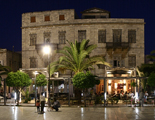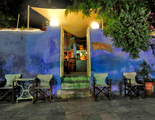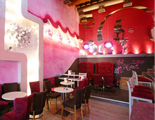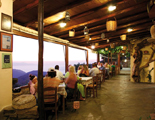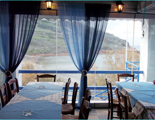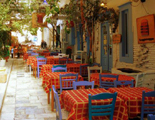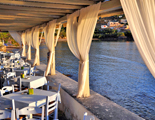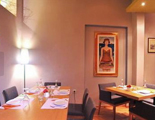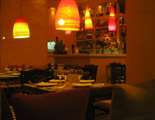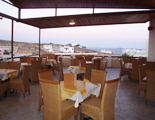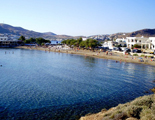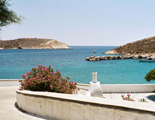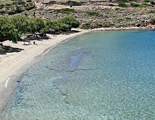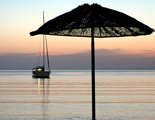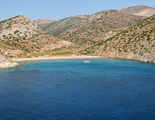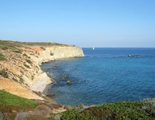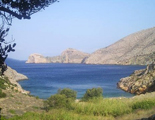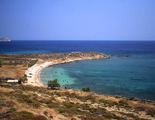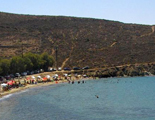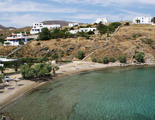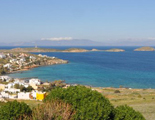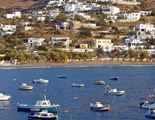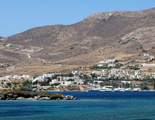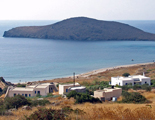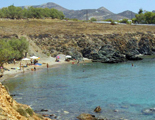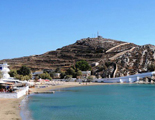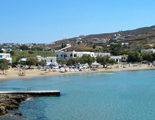 Syros Travel Guide
Syros Travel Guide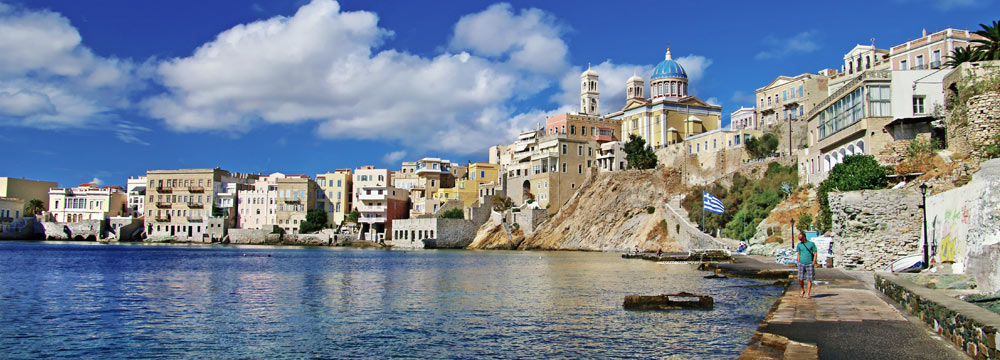
The Phoenicians were among the first inhabitants of Syros and the ones who eventually named the island. There are two possible explanations of the word Syros: either it comes from the word “Ousoura” or “Ousyra”, which in Phoenician means happy, or from the word “Syr” which means rock. Syros is also mentioned by Homer with the name Syrii.
There are signs of inhabitance of Syros in the 3rd millennium B.C. in the regions of Halandriani and Kastri. Findings indicate that there must have been a laboratory of metalwork on the island, which had commercial relations with Asia Minor. During the 2nd millennium B.C. the island was occupied by the Phoenicians, Cretans and Mycenaeans, while in the beginning of the 1st millennium B.C. by the Ionians. The Ionians were the ones who built Ermoupoli, the island’s capital till nowadays.
The period between 3,000 B.C. and 1900 B.C. is characterized as the period of the Cycladic civilization or Syros/Keros civilization, due to the fact that the culture developed in these two islands was the dominant culture at that time. Apart from valuable grave offerings discovered recently and the famous Syrian reflectors, Syros is also mentioned by Homer in Odyssey as a land of prosperity.
In the 6th century B.C., Syros was occupied by the Samians and many Samos’ inhabitants moved to the island. At that time, the important physician and philosopher Pherecydis was born in Syros and some years later he went to Samos and became the teacher of Pythagoras. Pherecydis invented the first sundial and two caves of Syros are named after him.
Ancient settlements were located in Galissas on the hill of Agia Pakou and on the west of Ermoupoli, whereas many agricultural settlements of the Ancient Period are dispersed across the island.
During the Classical Period Syros was a peaceful island that did not play an important role in the territories of Ancient Greece. It was a member of the Athenian Alliance and was autonomous, but had to pay subjection taxes to Athens. In 338 B.C., the Heronia Battle led the whole Cyclades complex under the Sovereignty of the Macedonians.
Syros totally changes during the Hellenistic Period as it becomes gravely more important. This is when the ancient theatre must have been built, whereas there are ruins of an ancient temple devoted to Asclepius in Grammata and findings in Alithini that indicate the existence of a temple devoted to Kaviri. During the Hellenistic Times, bronze coins are used for commercial transactions in Syros.
During the Roman period, Ermoupoli was the Island’s capital which had its own currency. In the beginning of the Roman Times (2nd century B.C.), silver coins were minted on the island, which was powerful and prosperous.
In the Byzantine Times, the pirates that dominated the Aegean Sea attacked the island and made its inhabitants move towards the inland. However, Syros was not abandoned. It was an island of Christians governed by the General, and later by the Duke of the Aegean region.
In 1204 Syros became a territory of the Venetians, which tried to impose a feudist system without succeeding. Syros was still attacked by pirates, although it was protected by the West due to the fact that the majority of inhabitants became Catholics and the Catholic Church was politically and economically powerful at that time. Only a small part of the Syriots remained Orthodox and they belonged to the parish of “Saint Nicholas the Poor”.
In 1579, the notorious pirate Barbarossa attacked Syros and occupied it on behalf of the Ottomans. Syros enjoyed many privileges like low taxes, no inhabitance of janissaries and religious liberty. Capuchins and Jesuits inhabited the island in the 17th and 18th century respectively.
In 1728 the island was hit by plague, but right after that it started recovering both in terms of economic and political aspect. In 1779 it was offered by the Sultan Abdul Hamit to the first of his nieces, Sah Soultana, which allowed an autonomous local government elected by the inhabitants. Between 1750 and 1820 the island’s population was doubled with inhabitants being concentrated in Ano Syros. Piracy was limited and the port of Ermoupoli became a very important commercial port. The Syriots were mostly occupied with wine commerce and shipping.
During the Greek Revolution in 1821, the Syriots were mostly neutral and did not participate in battles. Many inhabitants from other islands and mostly from Chios, which was destroyed in 1822, moved to Syros and created a new population comprising of Syriots, and former inhabitants of Chios, Psara, Samos, Rhodes, Kasos, Hydra and Smyrna. The new inhabitants organized settlements around Ano Syros and named them after their region of origin (Vrontado named after the homonymous villages in Chios, Psariana, Hydreika). This is how Syros became an island with a large population and a very important port (due to the needs of that population). In 1823, Ermoupoli’s hospital is the first hospital founded in Greece! The Neorio shipyard was constructed in 1826 and has played a very important role in the Greek shipping history ever since, whereas in 1860 Ermoupoli was the number one commercial port in Greece.
Syros became part of Greece in 1830, along with the other Cycladic islands. Arts and cultural expression were very important in the everyday life on the island.
In the beginning of the 20th century, many Syriots left the islands and decided to live in Piraeus and Athens which were under huge development. Syros went through a very difficult phase during the 2nd World War and specifically during the Italian/German occupation. Inhabitants suffered from hunger and they were buried in tombs instead of individual graves. At the end of the War, many important buildings and the shipyard were bombarded and destroyed.
Right after the War, Syros tried to recover with the development of wooden shipbuilding and agriculture. However, the population was in continuous decline since 1920 and in 1971 there were only 13.500 inhabitants on the island.
Starting 1990, the touristic development of Syros began thanks to the historic buildings of Ermoupoli and the rich culture of the island. Today, it is a prosperous island based on tourism and agriculture, while it also hosts the administrative headquarters of the Cycladic islands as well as a hospital and a university. Syros is the capital of the Cyclades.
Koiranos was a king of Syros in the early historic years. He was considered a charismatic king and a very intelligent person, and he was respected and honored by all Syriots for many years. According to the myth, Koiranos’ ship sank in the sea between Paros and Naxos and he was brought to Syros by a dolphin. The cave to which he arrived was named after him and is called “Koiranion Andro”.
Due to its position Syros was often used as a stopover for ships traveling in the Aegean Sea. Starting from the Ancient Times, navigators used to resort to the northeastern coast of the island and waited for storms to pass and strong winds to stop. According to the myth, this is why the rocks at Grammata are carved with symbols of various periods, because travelers used them in order to carve names and dates, but also prayers and thanks to the Gods.
Syros is not just another beautiful island, but an island with a vibrant culture and a strong passion for arts. Therefore, visitors should not neglect visiting museums and galleries, but should also relish walking around picturesque streets of traditional villages, and exploring gorgeous beaches and impressive caves.
Syros has many churches, both Catholic and Orthodox. Among them, the most impressive is the Orthodox Church of the Transfiguration of Jesus, which is the island’s metropolis. It is a basilica aisle with a dome and was built in 1824, which makes it the oldest Orthodox Church on the island.
Another historic Orthodox Church is the one of the Assumption of Virgin Mary, again in Ermoupolis, which is the second oldest church after the aforementioned and it was built in 1828-1829. Here visitors may admire a unique Orthodox image of Virgin Mary created by Dominikos Theotokopoulos (El Greco).
Moreover, the Church of the Resurrection on the hill of Deli in Ermoupoli is worth visiting, since it has an interesting architecture and was built between 1879 and 1909. The Church of Saint Nicholas in Vaporia concludes the list of Orthodox Churches in Ermoupoli that should not be missed; this church is among the five biggest churches in Greece and was being built for more than 60 years, whereas in its yard there is the Monument of the Unburied Fighter, dedicated to Greek fighters lost during the 1821 revolution. This is a sculpture created by the Tinian G. Vitalis.
Outside Ermoupoli travelers should definitely visit the Church of Prophet Elias in Episkopio, which is the church where the famous Greek author Elias Venezis was married, and the Monastery of Saint Barbara at Kini, where the nuns create textiles and embroideries in the traditional way, using a loom. In Ano Syros the only Orthodox Churches are the ones of Holy Trinity and the historic Church of Saint Nicholas the Poor, which was the only parish for Orthodox Christians when Catholics came to the island.
Among the most important catholic churches are the Church of Evangelistria in Ermoupoli built in the 19th century, the Church of Saint George in Ano Syros renovated in 1834 on an initial building of the 12th century, the Church of Saint Peter in Poseidonia and the Catholic chapels of Saint Pakou and Saint Stephen in Galissas, which offer a unique view to the visitors. In Ano Syros there is also the Abbey of Capuchins with the Catholic Church of Saint John built in 1635 and the Abbey of Jesuites with the Church of Virgin Mary of Karmilos that houses a large library with historic documents and manuscripts.
The Archaeological Museum of Syros (“Pankykladiko”) was founded in Ermoupoli in 1834-1835 and comprises of four halls in the famous Town Hall of Ermoupoli. The Museum houses archaeological findings from Syros and the other Cycladic Islands, starting from the 3rd millennium B.C. till the Hellenistic period. There is also an exhibition devoted to the archaeologist Christos Tsountas, who led the excavations in the Cycladic Islands in the 19th century.
This is another interesting museum, which hosts a rare collection of old machinery from the industries of Syros and an important record of oral testimony concerning the era of industrial development of the island. Among the most impressive exhibits is a large paddle wheel in the Museum’s yard, which was part of the historic Greek ship “Patris”. Visitors may also admire various objects related to shipping, machines’ accessories and even paintings related to the industrial era. Last but not least, the museum’s library is comprised of 400 technical books and the same number of industrial designs.
The Gallery of the Cyclades is located in the old building of the Transit Warehouses of Ermoupoli, built in 1834-1839 and designed by the Bavarian architect Erlacher. The Gallery houses important paintings, but also organizes art exhibitions and has an active theater.
The Replicas Museum of Cycladic Art, which is situated inside the Town Hall in Ermoupoli, hosts replicas of Cycladic objects that are exhibited in the Goulandris Museum of Cycladic Art in Athens. The Museum organized educational programs for children and adults, in order to present in an understandable way the Cycladic Culture of the 3rd millennium B.C.
The Ecclesiastical Museum of Ermoupoli was founded in 1984 and gathered objects from all the Cycladic Islands, including sacred vessels, vestments, books and Images. In 2011 the Museum was moved in the Metropolitan headquarters and entrance to the Museum is free of charge.
Syros is an island of culture and artistic expressions. As such, it could not but have a plethora of museums and galleries, which organize interesting events and impress their numerous visitors from all over the world.
The Museum of Ano Syros is a museum of folk life that houses a large collection of tools and objects of the everyday life of the Syriots through the centuries.
The Markos Vamvakaris Museum in Ano Syros is truly a treasure for the island; the Museum building is actually the house where this unique musician of “rebetiko” music lived and composed his amazing work. The building was renovated in 1995 and visitors may admire his personal objects, including clothes, his passport, manuscripts with lyrics and plenty of photographs.
Finally, the Cultural Center of the Municipality of Syros hosts art exhibitions and organizes various events all year long. It also houses the Municipal Library.
Although the island’s capital Ermoupoli is rather a town than a village with a population of 12,000 people, it deserves to be presented as a place to visit. This wonderful insular city devoted to Ermis, the ancient god of commerce, has it all: a magnificent Town Hall situated on a great square, Miaouli Square, similar to the squares of the modern European cities; a Municipal Library with about 35,000 books; an old aristocrats’ district, Vaporia, with neoclassical houses of unique architecture; the amazing Apollo Theater, a theater with a great history which was designed by Pietro Sampo in 1864 and has been totally renovated; numerous museums and galleries; shops and a vibrant nightlife; splendid beaches next to the city center; various accommodation choices; the first high school ever established in modern Greece, which was established in 1833 and among its students were former prime ministers, famous artists and important personalities in the Greek history; a historic shipyard, Neorio, with a separate part for the construction and repair of wooden ships; and last but not least, a hospital, a port and an airport. What more can visitors ask for?
At about 3.5 km. from Ermoupoli, there is the medieval village of Ano Syros. Visitors may enter the village from one of its three entrances and should be aware that access by car is not possible at the largest part of Ano Syros. Ano Syros is famous for its narrow streets and picturesque white houses interconnected with stairs, its traditional taverns with live music and flavoury food (among which the underground tavern where Markos Vamvakaris used to play), the Centre of Historic Research of the Catholic Diocese and the Historical Records of Ano Syros.
Visitors in this renowned village should be prepared to walk and enjoy the feeling of being in village that looks like an open air museum!
Episkopio Village
Yet another wonderful village of Syros, which was very prosperous in the 19th century but now is almost deserted, is Episkopio at about 4.5 km. from Ermoupoli. This was the island’s most important and most aristocratic resort with large villas built amphitheatrically and palm trees and statues of their owners adorning their wonderful gardens.
Visitors should walk up the stairs that lead to “Profitis Elias” and admire the breathtaking view of the port and the area around it.
Chroussa and similar villages
Chroussa, Parakopi and Dellagracia also have neoclassical houses that were mainly built in the 19th century and were used as summer homes. Chroussa is a traditional village in a rural area, which has two churches, an old holidaymakers’ club and a path that leads to Agia Thekla, which is considered among the oldest prehistoric settlements of Syros.
Pagos village & more
Pagos is another rural village that is famous for its slaughterhouses and the fact that it maintains the tradition of organizing celebrations before Christmas, which is the time period when fresh pork meat is being processed in different ways (e.g. it is turned into ham) in order to last all year long. Around Pagos there must have been settlements of the Hellenistic and Roman periods.
Finally, the most famous beaches of Syros like Galissas, Kini, Azolimnos, Vari, Megas Gialos and Foinikas are surrounded by settlements that offer accommodation and many services to visitors.
The most important archaeological sites of Syros are Halandriani and Kastri, where there used to be prehistoric settlements, close to each other, at the northeastern part of the island. At Kastri, the ruins of which are still visible, excavations revealed a prehistoric cemetery and brought to light important objects of the Cycladic Culture exhibited in the Archaeological Museum of Syros.
The Cemetery of Saint George, on the road that leads to Ano Syros, is more like an open air Museum with grandiose statues and sculptures that will definitely impress visitors. The Cemetery was inaugurated in 1834 and has a unique marble steeple in its entrance.
The Pherecydis' Caves are two caves in which the philosopher Pherecydis taught, located close to Ano Syros. The first cave is at about 1 km. from Ermoupoli in a position called “Alithini” and the second cave is at about 5 km. to the north of Ermoupoli at Platy Vouni. Both caves can be visited.
Moreover, hikers will most certainly enjoy the signaled paths in Ano Meria, which has joined the “Natura 2000 Network”. This is a region of wild beauty and organized hiking tours are arranged and performed by experienced guides. Similar paths also exist in the northern part of the island, where natural beauty is amazing and untouched by the human hand. The most remarkable path is the one that leads to “Eklogites”, which are big round rocks standing out of the landscape.
The Kini Aquarium is ideal for a family visit before a refreshing swim on the homonymous beach. Although it is not very big, it houses the representative sea species of the region and provides information on the activities related to the sea, as well as issuesrelated to environmental protection.
Finally the Lighthouse of Syros at Gaidouronisi has the oldest rotating beacon of the Aegean Sea. This stone lighthouse was built in 1834 and is about 30 m. high, whereas according to narrations it could be visible even by Smyrni, Asia Minor.
Location: Ermoupoli
CLIMATE
The climate in Syros is Mediterranean, which means that the winters are mild and the summers are hot with plenty of sunshine. Syros has about 2,900 hours of sunshine per year and snow is very rare. The average temperature in winter is 12.2°C, while during summertime it is 25.6°C, during spring 16.5°C, and during fall a little above 20°C. The fall is much hotter than the spring and this is why many travelers choose this period in order to visit the island. During the summer, and especially in July and August, the strong northern winds (“meltemia”) make the heat less intense. Finally, there is almost never fog at Syros.
TELEPHONE
The national prefix for Greece is +30 if you are calling from abroad. All numbers in the capital Athens start with the prefix 210 and are followed by 8 digits (e.g. 210-3227400).
The Area Code for Syros is: +30 22810. If you wish to call abroad, you have to start by dialing the other country’s national prefix (i.e. 0049 for Germany, 0044 for England etc.) and continue with the area code and the number where you wish to call.
CURRENCY
Euro €
Euro Coins: 1 and 2 euro coins (gold and silver color), 10, 20 and 50 cents (gold color) 1, 2 and 5 cents (copper color)
1 euro = 100 cents / centimes.
Euro Bank Notes: Are available in 5, 10, 20, 50, 100, 200 and 500. It is not always easy to receive change for 200 and 500 Euro Notes.
BY AIR
Syros has an airport which is directly connected with the Athens International Airport on a daily basis during the summer. The flight lasts 25 minutes, but travelers need to book their flight early, because there is only one airline on this itinerary.
Syros Airport Tel.: +30 22810 81900, +30 22810 87025
BY BOAT
Syros is connected to Piraeus by boat and high-speed, and to Rafina by high-speed on a daily basis during the touristic period (May-October). The trip from Piraeus lasts about 4 hours by ship and 2.5 hours by high-speed, whereas from Rafina port the trip duration is 1.5 hour.
Moreover, the island is connected by boat or high-speed with all the Cycladic islands and also Crete, Dodecanese, Thessaloniki and Skiathos.
For information on ports and schedules, visit the following links:
Hellenic Seaways: www.hellenicseaways.gr
G.A. Ferries: www.gaferries.gr
Blue Star Ferries Tel: +30 210 8919800
NEL Lines Tel: +30 210 4115015
LOCAL BUSES
Local transportation is well organized and covers a large part of the island, specifically during the summer. The local bus connects Ermoupoli to Galissas, Foinikas, Poseidonia, Mega Gialos, Vari, Azolimnos, Kini, Ano Manna, Chroussa, Parakopi and Vissa. There are municipal buses that are free. Travelers may get more information from the Municipality of Syros.
Tel.: +30 22810 82575
TAXI SERVICE
Taxis are available on the island, and they usually wait in Ermoupoli in front of the Monument of National Resistance.
Taxi Services: Tel.: +30 22810 84222, +30 22810 86222
BOAT
Daily excursions are organized to secluded beaches, and also to top diving destinations, all around the island. These excursions are organized upon request and travelers should consult local travel agencies for information.
In addition, there are diving packages that also include accommodation and transportations services.
BANKS & ATMs
Many banks have branches and ATMs in Ermoupoli, so you will definitely find one to serve your needs. The Greek banks operate From Monday to Thursday from 8am to 2.30 pm while on Fridays they are open for the public from 8 am to 2pm.
MONEY EXCHANGE
Money can be exchanged in all bank branches.
POST OFFICE
The Greek post office is called ELTA and you can find the main post offices of the island in Hora where there is also a branch of the Hellenic Post Bank. Post Boxes in Greece are YELLOW for normal post, usually with 2 slots for INTERNAL POST (meaning inside Greece) and post for ABROAD. RED Post Boxes are rarer and they are used for URGENT mail. You shouldn’t expect to find such boxes on the island. REGISTERED mail is always handled and given a receipt for at the POST OFFICE.
The Post Office in Syros is located in Ermoupoli.
Syros Post Office Tel: +30 22810 82590, +30 22810 82596
POLICE STATION
Police Station Tel.: +30 22810 96100, +30 22810 96112, +30 22810 96127
Municipal Police Tel.: +30 22810 82525
MUNICIPALITY OF SYROS
Previously, Syros was divided in three municipalities: Ermoupoli, Poseidonia and Ano Syros. However, these three municipalities have been united into one central Municipality, called the Municipality of Syros, which is located in Miaouli Square.
- Radio Taxi: +30 22810 84222, +30 22810 86222
- Syros Port Authority: +30 22810 88888, +30 22810 82690
- Hellenic National Meteorological service: +30 2109699101-3
- Elpa (Car breakdown tourist information service): 174
- Police: 100
- Fire Department: 199
- Ambulance: 166
Syros Hospital “Vardakeio & Proio”: Ermoupoli, Tel: +30 22810 96500, +30 22810 86666, +30 22810 96523
PHARMACY
There are more than 20 pharmacies in Syros, located in Ermoupoli, Poseidonia, Foinikas, Kato Manna and Talanda.
Those looking for a small, organized beach with many accommodation alternatives nearby and a cosmopolitan character will certainly love Poseidonia. This sand and pebbles' beach lies in front of the homonymous holiday resort and attracts yacht owners due to the little port right next to it. The natural ambience is very beautiful with tamarisk trees hanging over the transparent blue water and golden sand. Access to Poseidonia, also called Dellagracia, is quite easy by private or public vehicles or by yacht.
With "achladi" being the Greek word for pear, it is not by accident that this beach is called like that. The almost round bay at the end of which the beach is located is truly picturesque with its little port full of fishing boats and traditional taverns by the sea. Access to Achladi is easy by car and there is an open parking space behind the beach.
Lotos is a little tranquil sandy beach very close to Kini. It is neither organized, nor does it have a tavern, cafeteria or beach bar. What this beautiful beach offers is serenity and isolation. Tamarisk trees provide natural shade and visitors can also relish a magical view to this gorgeous bay. Nature and tranquility lovers may easily arrive here by car or motorcycle.
Competing with Kini for the best sunset on the island, Galissas is a very long sandy beach with transparent waters, attracting a vibrant crowd comprised mainly of youngsters. This is the largest beach on the island (along with Megas Gialos) and it is fully organized, with sunbeds, umbrellas, taverns, cafeterias and water sports facilities. The homonymous village of Galissas is probably the most renowned resort of Syros and offers great accommodation choices, along with a vibrant nightlife.
Varvarousa, Aetos, Lia, Marmari and Grammata are isolated beaches in the northwestern coast of Syros, accessible only by boat or via difficult paths starting at Delfini or Apano Meria. All these beaches are totally isolated and have turquoise waters. Most of them have tamarisk trees that offer natural shade, whereas at Grammata there are also pine trees by the sand. Grammata is also preferred by free campers, whereas Varvarousa attracts sailing yachts. These beaches are hidden paradises indeed.
Ambela is a gorgeous creek in Southern Syros, next to Megas Gialos. This cozy beach has thick dark brown sand and a wonderful view to the endless horizon of the Aegean Sea. Thanks to its orientation, Ambela is protected from northern winds and it has calm, shallow waters, ideal for children. A few picturesque white houses of Cycladic architecture complete the beauty of the landscape, whereas there are also a few palm trees right next to the sand.
Fokiotrypes are little creeks at the most eastern end of Syros, formed by rocky hills, pebbles and sand. They are totally isolated and access to this area is possible either by boat or via a path that begins at Azolimnos. The waters here are so clear and the area is so tranquil that a part of the Monahus-Monahus seals population selects Fokiotrypes to deliver its eggs. A swim on these rocky beaches is a truly unique experience
Surrounded by white rocks and rocky cliffs that form a long U-shaped bay, this beach with turquoise waters is a little paradise on earth. The fact that it is isolated and tranquil even in August explains why it is among the top choices for nudists. Access to Armeos or Agia Pakou is possible via a path which starts at Galissas, climbs over the hill with the homonymous chapel and finally arrives at Armeos. Alternatively, the beach is accessible by boat.
Sandorinioi is a little isolated beach in between Azolimnos and Vari. The landscape is amazing and strangely shaped rocks come out of the sea water; which, chiseled by the waves, are almost white in their lower part and dark grey on the top. Due to its orientation, this beach is protected from the seasonal northern winds, a fact that further enhaces the serenity offered to visitors. Access is easy by car/motorcycle.
"Fabrika" is the Italian word, also used in Greek, for factory as, right at this beach, used to be a factory during the period of the island's economic prosperity. Fabrika is a little southern beach with very few umbrellas and pretty tranquil. At its one end, there are rocks that create a little shelter for nudists. Next to the beach there are taverns serving fresh fish and seafood. Access is easy by car/motorcycle.
Only 1 km. south from Agathopes, this little organized beach makes visitors almost feel like home. It offers umbrellas and sunbeds, natural shade from tamarisk trees, and the option for water cycling. Komito is never too crowded and its waters are crystal clear. Access to this beach is easy via Poseidonia and visitors may park their cars right behind the beach for free.
Megas Gialos is a holiday resort in the southern part of Syros. Its beach is very long, but quite narrow, and has tamarisk trees all along it. Megas Gialos is an organized beach with sand and a few pebbles, also offering the possibility to rent a pedalo and enjoy water cycling. Among the interesting things of Megas Gialos are the high reeds that stop where the sand begins. Around the beach there are taverns and apartments/rooms to let.
Azolimnos is a picturesque beach on the southeastern part of the island, offering many accommodation choices, taverns and cafeterias. It is an organized beach with thin golden sand and clear waters, which also offers natural shade with its beautiful tamarisk trees. Visitors may arrive here by bus, car/motorcycle, or by boat which they can moor on the little port right next to the beach. Azolimnos is really impressive when it is windy, with huge waves climbing over the port’s docks
Kini is the ideal setting for couples looking for a romantic vacation. It has the best sunset on Syros, picturesque taverns by the sea, a little port, and tamarisk trees hanging over the sea. It is quite spacious, with thin sand and transparent shallow waters, whereas it offers various accommodation proposals and water sports. Access is very easy by bus or private vehicle and the taverns here serve fresh fish and seafood, providing travelers with one more reason for choosing Kini.
Foinikas is a sandy beach with calm waters at the end of a beautiful bay, which creates a natural shelter against the winds due to its orientation. Visitors here can find anything they may require: tamarisk trees that provide natural shade, sunbeds and umbrellas, cafeterias, water sports facilities, an organized port for yachts and excellent traditional taverns serving local dishes. The area around the beach offers diversified accommodation choices.
This is a very long sandy beach with crystal clear waters, offering visitors umbrellas and sunbeds. The coastal orientation and the beautiful bay around Delfini create a natural shelter, protecting it from the strong northern winds. Although Delfini hosts some taverns and is partially organized, it is a tranquil beach that creates the illusion of an exotic island. Access is easy by car/bus via a dirt road or via a path starting at Kini (20 minutes’ walk).
Kymata, Agios Nikolaos, Taliro and Vangelidi are four beaches located in Ermoupoli, which means that they are directly & easily accessible without having to leave the Island's capital. They are all small pebble beaches, right next to the center of Ermoupoli. Agios Nikolaos, named after the homonymous church, is the only one of them that is also partially sandy. These beaches are not organized, but being located in Ermoupoli, they offer anything visitors may require.
With "Kokkina" meaning objects of red color in Greek, it is quite obvious why this beach is called Kokkina. This tranquil little bay, with ruddy brown sand and pebbles, is surrounded by reddish rocks that compose an undeniable wild beauty. Visitors may access this beach by walking down a path from the beach of Foinikas, which lies right next to Kokkina, and should make provisions for water, snacks and mats.
Gaidaros or Fanari is a little island on the east of Syros, quite close to Ermoupoli. This isolated island is easily accessible by boat from Ermoupoli and many visitors choose to go for a swim on its famous beach Megali Agali, which hosts the oldest rotating beacon of the Aegean Sea built in 1834. The lighthouse is about 30 m. high and it gives a nostalgic note to this tranquil sandy beach with crystal clear waters.
Ideal for children, this organized sandy beach with shallow waters offers everything a family may require: clear and calm waters, thick sand suitable for building sandcastles and easy access. There is also the possibility for sports, like beach volley and water sports. Along the beach there are sunbeds and umbrellas, and around it there are taverns, cafeterias and multiple accommodation choices.
Agathopes is an organized sandy beach with shallow waters, which is very popular and also offers water sports' facilities. The beach has a wonderful view to the little islands of Schinonisi and Stroggylo, whereas this blessed narrow piece of land surrounded by sea, hosts beautiful sea lilies. The water is crystal clear and during springtime, the Monachus-Monachus seals deliver their eggs on the golden sand of Agathopes. The beach has a beach bar and taverns, serving delicious local dishes.
Syros is a part of the Cyclades Islands, all famous for their traditional recipes with emphasis on fish, seafood and local herbs. Specifically in Syros, there are some unique recipes coming from different parts of Greece, since the island was inhabited by groups of people coming from numerous different islands in the 19th century.
This is truly a gastronomic pleasure, since it combines the strong taste of octopus with the unique taste of sundried tomatoes. The ingredients also include vinegar and/or wine, olive oil, capers, rosemary, thyme and pepper. Other herbs may be added according to personal preferences.
This spicy type of cold cut is made throughout Cyclades, with small variations in each island. In Syros, the meat is initially covered in salt for 24 hours and then it gets further seasoned with pepper, cinnamon, cloves and allspice; it is wrapped up in intestine and pressed overnight in order to take its characteristic shape. Then, it is hung for two months in order to dry.
Delicious sundried mackerel cooked on the grill. This recipe for salted fish is very conveniently maintained for many years now.
First the meat is cut into large pieces and sautéed with olive oil in a pot. Then, the onions are added to follow the same procedure as the meat and last the wine, potatoes, fennel paste and salt and pepper, in this order. Finally we add water and cook in the pot for about an hour. The result is a delicious dish with a distinctive flavor.
Although this pie has the philosophy of the traditional Greek spanakopita (spinach pie), it is different because apart from crust, olive oil, spinach and onions, it also has sausages cut into rings and fennel. This combination is really amazing.
This dish is served in taverns by the sea and everyone loves it. It is based on the mixture of the flavors of onions, first boiled in water and then dried in olive oil, and smelt, which is seasoned with salt and pepper and fried after it has been floured.
The “art” of making loukoumi (Turkish delight) was brought to Syros by the Chians that arrived on the island in the 19th century. The loukoumi of Syros is the number one loukoumi in Greece. Made of starch, sugar, glucose, water and sometimes nuts, it is often flavored by rose water, vanilla or mastic.
This sweet snack is the trademark of Syros since 1840. It is made of almonds, locally produced honey, sugar, egg’s albumen and vanilla. It is easy to transport and does not need to be preserved in the fridge. Travelers should definitely bring some halvadopites home with them choosing from the great variety of tastes: vanilla, mastic and chocolate, plain or with nuts and almonds.
These are delicious dry figs, baked in the oven and held together by sesame, cinnamon, almonds and laurel leaves.
There are about 700 hives in the northern part of Syros producing fine quality thyme honey, which is sold throughout Greece and also abroad.
The production of olives and olive oil is among the top agricultural activities on the island. A jar of “tsakistes elies” (crushed olives) in brine is certainly worth buying.
Considering that 50% of the agricultural activity involves vines, it is no coincidence that the Syriot wines are of fine quality and also very famous. Among them, Savvatiano, Serfiotiko or Monemvasia, and white (“Avgoustiatis” and “Kastano”) or red (“Armeletousa, Proniko, Romeiko”) are fine local wines, which will satisfy even the most demanding wine taster.
Syros is famous for its delicious cheeses made mainly with goat milk, sheep milk and cow milk. The most famous local cheeses are fresh “myzithra”, sweet cow gruyere and little round cheeses called “petrota”. However, the most unique cheese of Syros is called “San Michali” and it is a cow cheese with a strong spicy flavor.
The local herbs of Syros are renowned for their aroma and flavor. Specifically oregano and capers are exported throughout the world, while fennel is used to produce a wonderful paste that can be used as an ingredient in many recipes, especially those including meat.
The Syriot Carnival is among the most famous carnivals in the Cyclades and it is held during the Carnival Period in February. It involves a big carnival parade, singing and dancing and the traditional “zeimbekia”, where men are dressed in traditional black costumes and dance around the streets of Ano Syros this dance of warriors. The “zeimbekia” revival is truly a unique spectacle, with men pretending to try to dirk each other in order to kidnap the wife of the captain. Carnival events are held not only in Ano Syros, but also in Ermoupoli and Foinikas.
The Guitar Festival of Ermoupoli is held every summer, usually in early July, and attracts guitarists from all over the world. This year (2012) will be the festival’s 19th consecutive year and it will take place on July 2, 2012 – July 6, 2012. The 19th Guitar Festival of Ermoupoli includes solo concerts, guitar teaching, a guitar competition for new musicians and the final concert of the festival’s guitar orchestra. For more information: www.guitarfestival.gr.
This festival is organized annually at the end of the summer (early September)and includes art exhibitions, theater plays, concerts and sailing races. More information is available from the municipality of Syros.
On June 14, the custom of “Kleidonas” takes place in Chroussa with the burning of the wreath of flowers that is handmade every year on May 1st to celebrate spring.
Vikeleia are aquatics that last three days and are organized in honor of Demetrios Vikelas, the man who proposed the revival of the Olympic Games in modern history whose birthplace was Syros. He also was the first ever president of the Olympic Committee.
Avgoustiatika Feggaria (which means “The moons of August”) is a series of nocturnal events organized in Ano Syros. Musicians of the island’s famous traditional music, “rebetiko”, are gathered in Ano Syros and play this unique sort of music in little taverns called “koutoukia” and around the streets of the village.
And last but not least, the museums and galleries of Syros organize various events each year on which visitors may be informed from the Municipality of Syros.
Many religious feasts are organized in different parts of the island in honor of Catholic and Orthodox saints. Feasts include eating, drinking and dancing, and they are far too many to mention. However, the feast of Virgin Mary on August 15 in Vari is combined with a glorious welcome of tourists there. The view of little boats decorated with flowers entering the bay is impressive, while visitors enjoy local dishes and local wine and listen to folk Greek music. Dancing often lasts all night long! Similar events are organized on the same date in Kini, where on August 14 takes place the custom of Fotarides with fires being lit along the beach, drinking, eating and dancing.
Syros is a beautiful island with unique architecture and many narrow streets with picturesque neighborhoods and traditional, island houses. Visitors should expect that they will walk a lot and therefore they should bring flat/athletic shoes with them.
In addition, visitors should be aware that the nights at the Aegean Islands are chilly due to the winds and high humidity. So, a light jacket is always useful.
Finally, visitors traveling from abroad may find visiting Syros during fall (apart from more economic) more pleasant, since the heat is less intense than in the summer, but the sea temperature is still quite high.
Syros has a long tradition in a unique kind of Greek music called rebetiko, which has a philosophy similar to the philosophy of blues. The greatest Greek musician of this kind, the most renowned “rebetis” was Markos Vamvakaris who was a Syriot. Today, his son continues his tradition. There are several small taverns with live music on the island, called “koutoukia”, where visitors may enjoy this truly unique sound. Do not miss it!
Boat tickets should be pre-booked, especially in July and August. Since there is a large demand during the summer months, travelers should book in advance their boat tickets. Also, by pre-booking, tickets can be bought at a lower price.
The Aegean Sea is often very windy, especially in August due to the estate winds (“meltemia”). Therefore, visitors should prefer beaches that offer a natural shelter and have calm waters, like Delhpini, Vari, Foinikas, or Kokkina.
Syros is increasingly attracting divers due to the large number of caves, shipwrecks, reefs, different fish species and even seals that can be found around its sea. There are two scuba diving schools in Syros, where equipment can also be rented, the Salt Water Diving and Syros’ Diving centre, both in Ermoupoli.
Syros is an island with a deep culture so various interesting artistic events are held on the island, attracting numerous visitors.The majority of shops are located in Ermoupoli and Ano Syros, but visitors will be surprised to find various shops in most villages of the island.
To Karavi Gallery“To Karavi”, which means the ship in Greek, is an interesting gallery with art objects created by two artists that live and work together, Lena Anesti and Vasilis Michailides. Visitors may find paintings and art objects, as well as interesting creations made of old wooden and metal objects. The majority of artistic representations have ships and boats as a theme.
Piaza, Ano Syros.
Tel.: +30 22810 84230.
Elikas Gallery
Elikas is a gallery that hosts numerous art exhibitions of various artists.
Klonos Str. & Kyparissou Stefanou Str., Ermoupoli
Tel.: +30 22810 84670.
Ermoupoli Gallery
This gallery organizes and hosts important art events and exhibitions covering a wide range of artistic expression.
Miaouli Square, Ermoupoli.

 Print this page
Print this page